UWB Dual-Band-Notched Lanky-Leaf-Shaped Antenna with Loaded Half-Square-Like Slots for Communication System
Abstract
:1. Introduction
2. Slot Antenna Model
3. Results and Discussion
3.1. Simulation and Measurement Results
3.2. Future Application Performance Evaluation
4. Conclusions
Author Contributions
Funding
Conflicts of Interest
References
- Darvish, A.; Zakeri, B.; Fallah, P. 50–100 Ohms 130 MHz–5 GHz resistively loaded bow-tie antenna for efficient UWB mono-pulse radiation. AEU Int. J. Electron. Commun. 2021, 138, 153807. [Google Scholar] [CrossRef]
- Serhir, M.; Lesselier, D. Wideband reflector-backed folded bowtie antenna for ground penetrating radar. IEEE Trans. Antennas Propag. 2018, 66, 1056–1063. [Google Scholar] [CrossRef]
- Liu, H.W.; Ku, C.H.; Wang, T.S.; Yang, C.F. Compact monopole antenna with band-notched characteristic for UWB applications. IEEE Antennas Wirel. Propag. Lett. 2010, 9, 397–400. [Google Scholar] [CrossRef]
- Federal Communications Commission. Federal Communications Commission Revision of Part 15 of the Commision’s Rules Regarding Ultra-Wideband Transmission System from 3.1 to 10.6 GHz; ET-Docket: Washington, DC, USA, 2002.
- Fan, F.; Yan, Z.; Zhang, T.; Song, Y. Ultra-wideband planarmonopole antenna with dual stopbands. Microw. Opt. Technol. Lett. 2010, 52, 138–141. [Google Scholar] [CrossRef]
- Chu, Q.X.; Yang, Y.Y. A compact ultrawideband antenna with 3.4/5.5 GHz dual band-notched characteristics. IEEE Trans. Antennas Propag. 2008, 56, 3637–3644. [Google Scholar] [CrossRef]
- Li, W.T.; Shi, X.W.; Hei, Y.Q. Novel planar UWB monopole antenna with triple band-notched characteristics. IEEE Antennas Wirel. Propag. Lett. 2009, 8, 1094–1098. [Google Scholar]
- Lin, C.C.; Jin, P.; Ziolkowski, R.W. Single, dual andtri-band-notched ultra-wideband (UWB) antennas using capacitively loaded loop (CLL) resonators. IEEE Trans. Antennas Propag. 2012, 60, 102–109. [Google Scholar] [CrossRef]
- Wang, P.; Wen, G.J.; Huang, Y.J.; Sun, Y.H. Compact CPW-fedplanar monopole antenna with distinct triple bands for WiFi/WiMAXapplications. Electron. Lett. 2012, 48, 357–359. [Google Scholar] [CrossRef]
- Patil, S.; Singh, A.K.; Kanaujia, B.K.; Yadava, R.L. A low-profile triple-band circularly polarized wide slot antenna for wireless systems. Int. J. Microw. Wirel. Technol. 2019, 11, 67–75. [Google Scholar] [CrossRef]
- Vendik, I.B.; Rusakov, A.; Kanjanasit, K.; Hong, J.; Filonov, D. Ultrawideband (UWB) Planar Antenna with Single-, Dual-, and Triple-Band Notched Characteristic Based on Electric Ring Resonator. IEEE Antennas Wirel. Propag. Lett. 2017, 16, 1597–1600. [Google Scholar] [CrossRef]
- Trang, N.D.; Lee, D.H.; Park, H.C. Design and analysis of compact printed triple band-notched UWB antenna. IEEE Antennas Wirel. Propag. Lett. 2011, 10, 403–406. [Google Scholar] [CrossRef]
- Abdollahvand, M.; Dadashzadeh, G.; Mostafa, D. Compact dual band-notched printed monopole antenna for UWB application. IEEE Antennas Wirel. Propag. Lett. 2010, 9, 1148–1151. [Google Scholar] [CrossRef]
- Li, W.T.; Hei, Y.Q.; Feng, W.; Shi, X.W. Planar antenna for 3G/Bluetooth/WiMAX and UWB applications with dual and-notchedcharacteristics. IEEE Antennas Wirel. Propag. Lett. 2012, 11, 61–64. [Google Scholar]
- Ranjan, P.; Kumar, A. Circularly Polarized Ultra–Wide Band Filtering Antenna with Controllable Band-Notch for Wireless Communication System. AEU-Int. J. Electron. Commun. 2021, 135, 153738. [Google Scholar] [CrossRef]
- Peng, L.; Ruan, C.L. UWB band-notched monopole antenna design using electromagnetic-bandgap structures. IEEE Trans. Microw. Theory Tech. 2011, 59, 1074–1081. [Google Scholar] [CrossRef]
- Saha, C.; Siddiqui, J.Y. Theoretical model for the estimation of resonance frequency of rotational circular split ringresonator. Electromagnetics 2012, 32, 345–355. [Google Scholar] [CrossRef]
- Taheri, M.M.S.; Hassani, H.R.; Nezhad, S.M.A. Compact printedcoplanar waveguide-fed ultra-wideband antenna with multiple notchedbands. Microw. Opt. Technol. Lett. 2012, 54, 2121–2126. [Google Scholar] [CrossRef]
- Nguyen, D.T.; Lee, D.H.; Park, H.C. Very compact printed tripleband-notched UWB antenna with quarter-wavelength slots. IEEE Antennas Wirel. Propag. Lett. 2012, 11, 411–414. [Google Scholar] [CrossRef]
- Mohammadi, S.; Nourinia, J.; Ghobadi, C.; Majidzadeh, M. Compact CPW-fed rotated square-shaped patch slot antenna with bandnotched function for UWB applications. Electron. Lett. 2011, 47, 817–819. [Google Scholar] [CrossRef]
- Xu, H.; Xu, K.D.; Nie, W.; Liu, Y.H. A Coplanar Waveguide Fed UWB Antenna using Embedded E-shaped Structure with WLAN Band-rejection. Frequenz 2018, 72, 325–332. [Google Scholar] [CrossRef] [Green Version]
- Jaglan, N.; Gupta, S.D.; Kanaujia, B.K.; Srivastava, S. Band notched UWB circular monopole antenna with inductance enhanced modified mushroom EBG structures. Wirel. Netw. 2018, 24, 383–393. [Google Scholar] [CrossRef]
- Verma, A.; Parihar, M.S. Multifunctional Antenna with Reconfigurable Ultra-Wide Band Characteristics. Radioengineering 2017, 26, 647–654. [Google Scholar] [CrossRef]
- Peddakrishna, S.; Khan, T. Design of UWB Monopole Antenna with Dual Notched Band Characteristics by Using cs by Using ce e WLAN Band-reject. AEU-Int. J. Electron. Commun. 2018, 96, 107–112. [Google Scholar] [CrossRef]
- Yadav, D.; Abegaonkar, M.P.; Koul, S.K.; Tiwari, V.; Bhatnagar, D. A compact dual band-notched UWB circular monopole antenna with parasitic resonators. AEU-Int. J. Electron. Commun. 2017, 84, 313–320. [Google Scholar] [CrossRef]
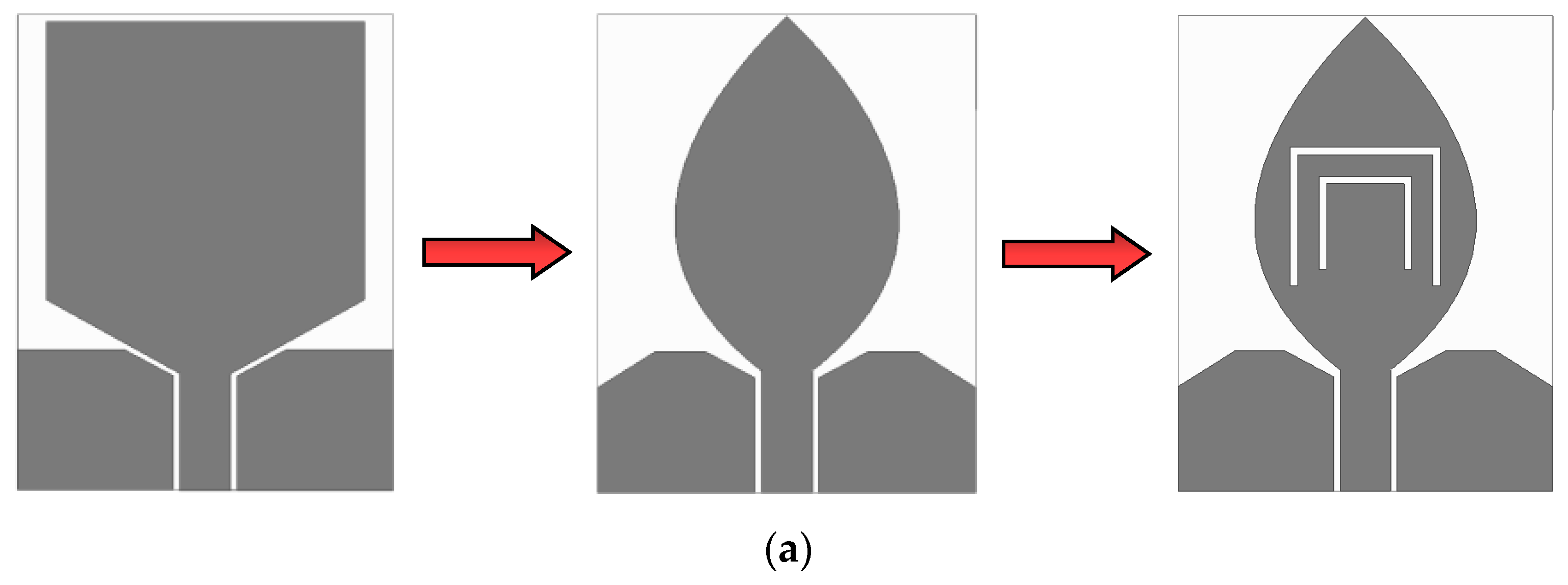


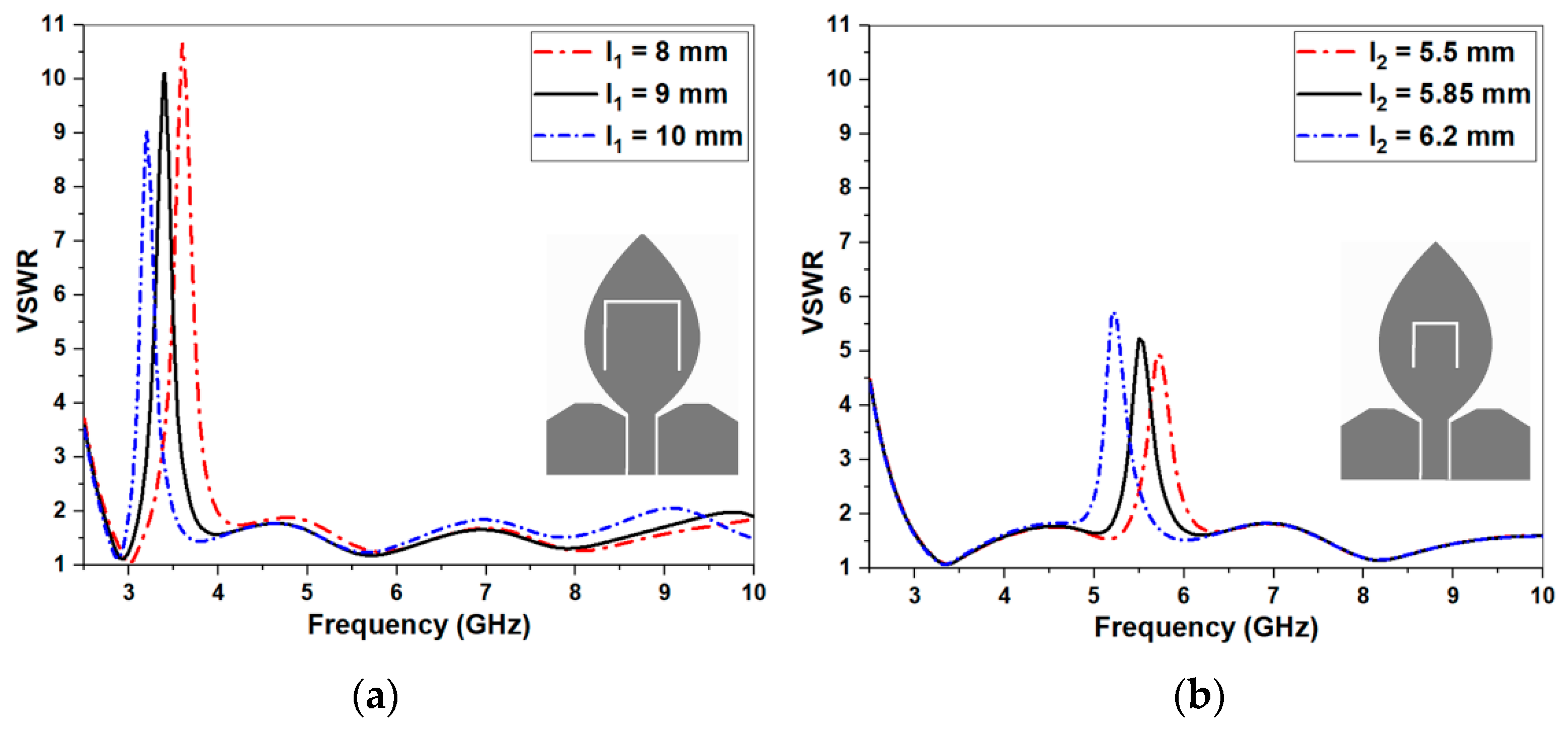
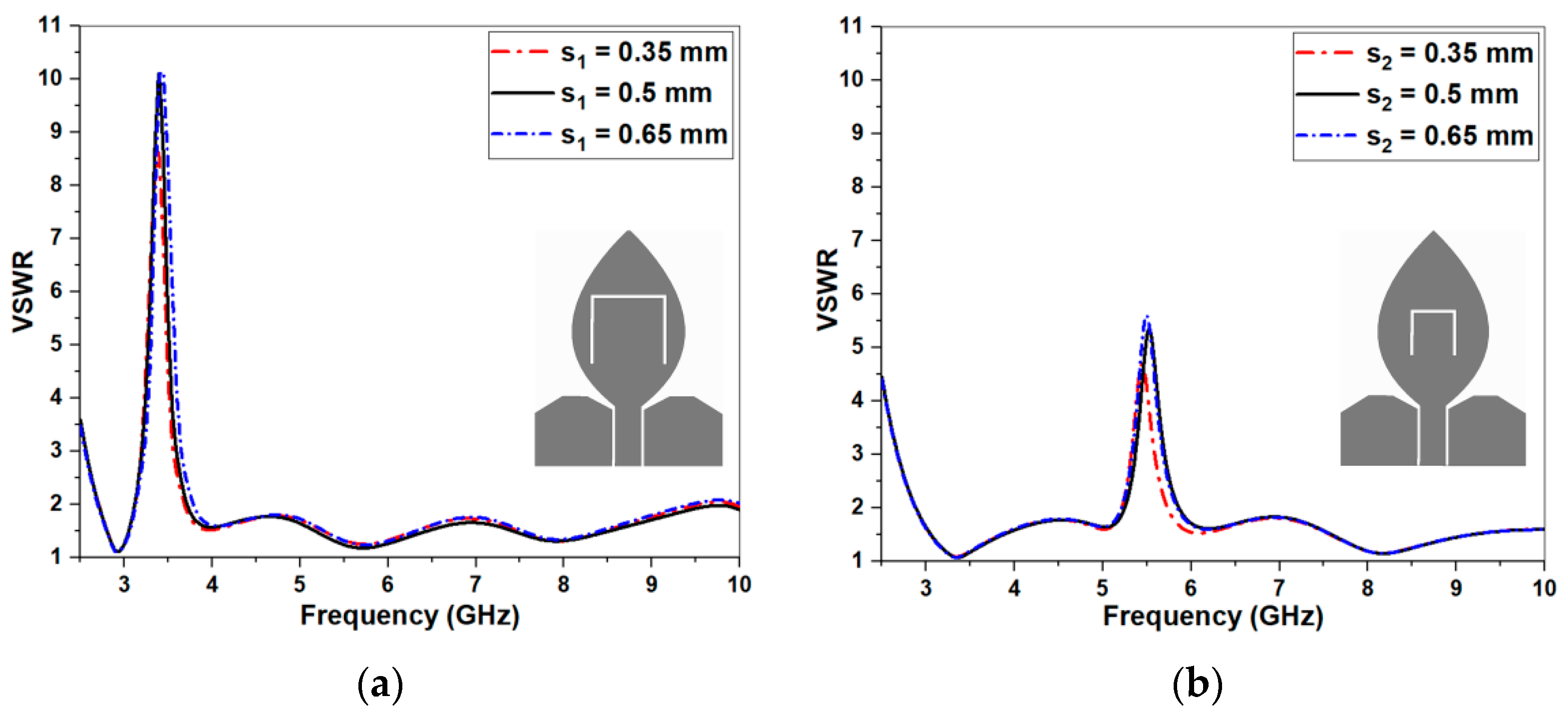
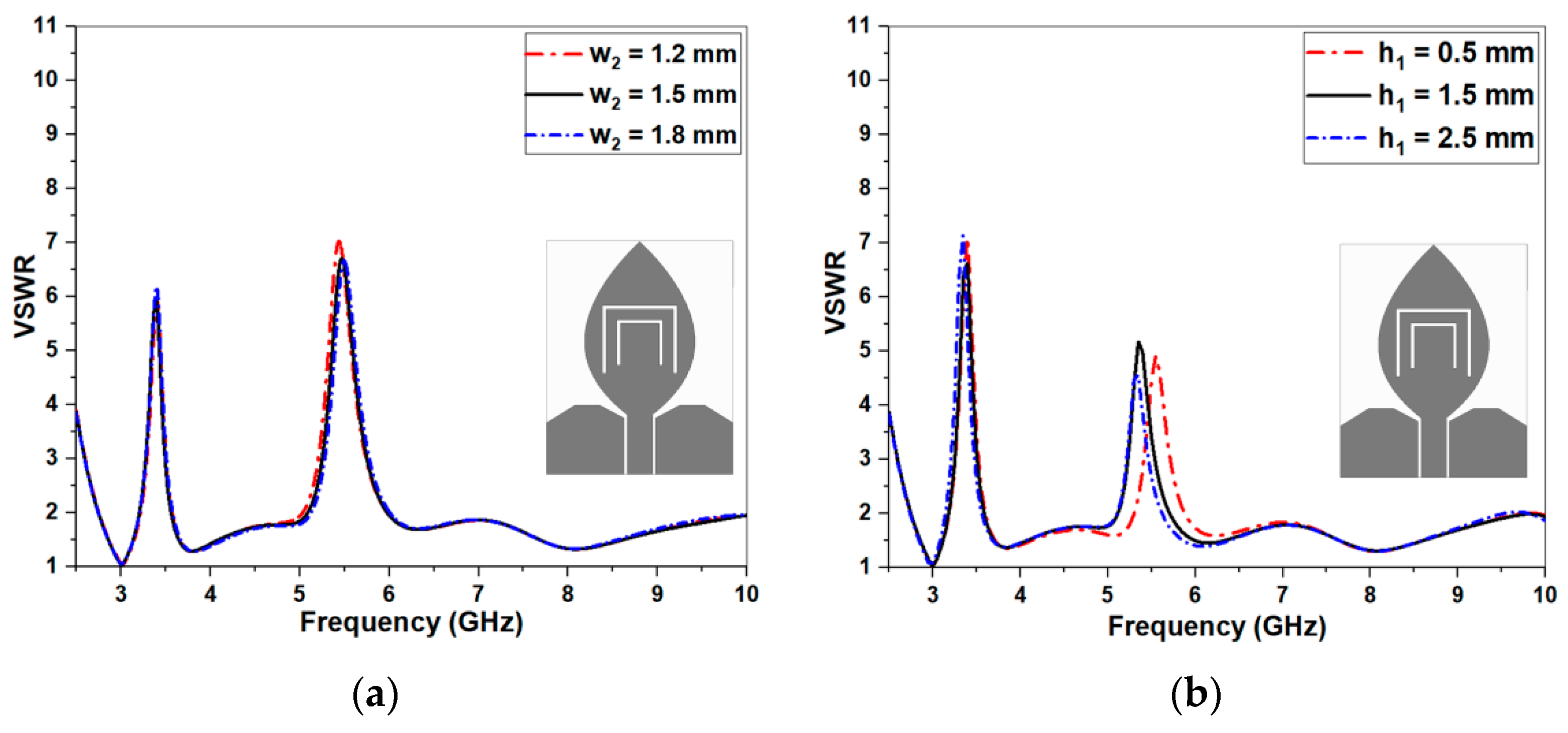



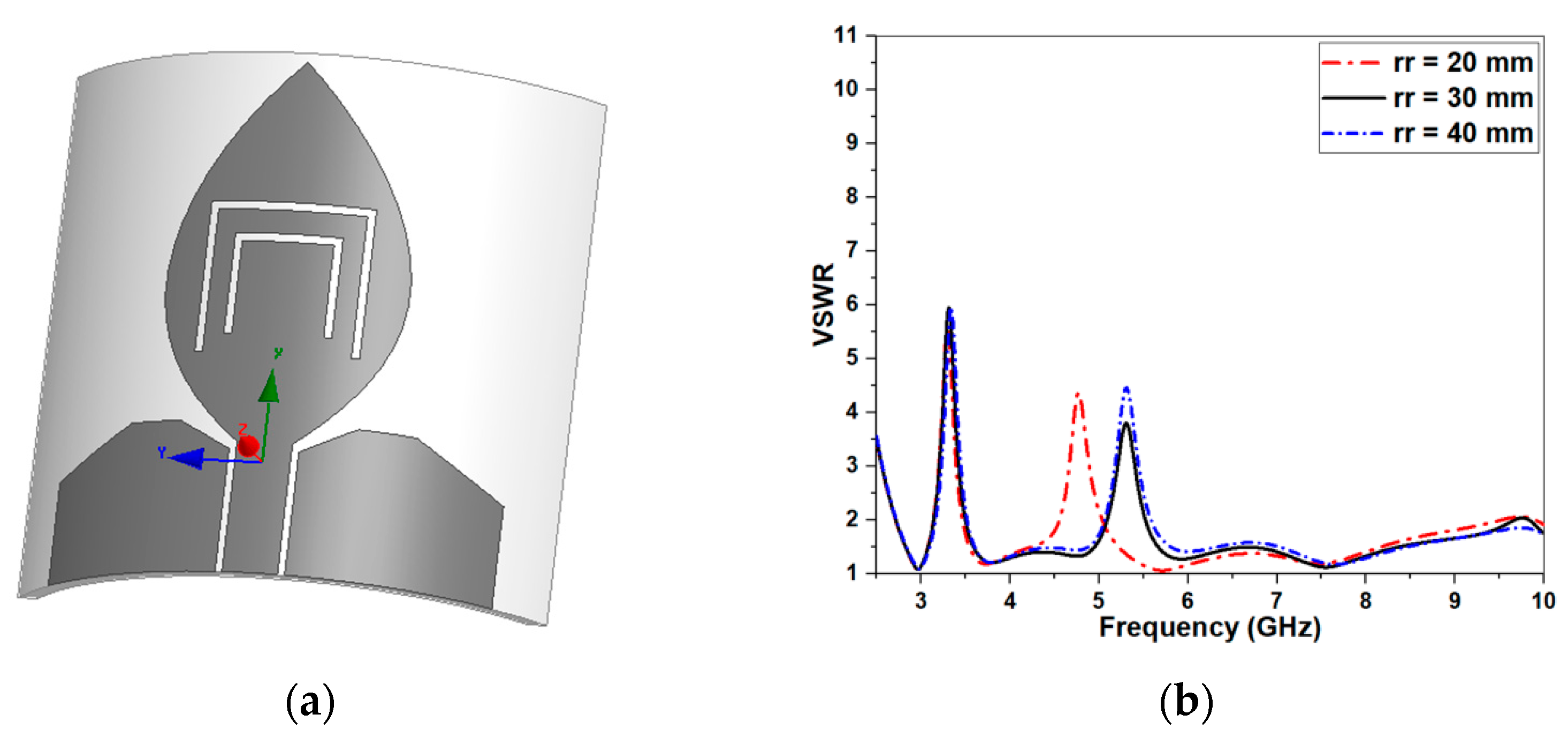

| Parameter | L | W | S | S1 | S2 | G | Fw | L1 | L2 | L3 | W1 | W2 | W3 | W4 | H1 | H2 |
|---|---|---|---|---|---|---|---|---|---|---|---|---|---|---|---|---|
| Unit (mm) | 32 | 27 | 0.45 | 0.5 | 0.5 | 10.8 | 3.5 | 9 | 5.85 | 2.44 | 5.8 | 1.5 | 4 | 3.38 | 1.5 | 8.9 |
| Ref. | Physical Size (mm2) | Electrical Size (λ02) | Substrate | Bandwidth (GHz) | Rejection Band (GHz) | Gain (dBi) |
|---|---|---|---|---|---|---|
| [21] | 27 × 31 | 0.28 × 0.32 | FR4 | 118% (3.1–12) | Single (5.2–5.8) | 1–4 |
| [22] | 42 × 50 | 0.29 × 0.35 | FR4 | 140% (2.1–12) | Single (3.3–3.8) | 2–7 |
| [23] | 40 × 40 | 0.41 × 0.41 | Duroid 5870 Rogers | 109.5% (3.1–10.6) | Dual (3.4–4.1, 5.2–5.6) | 4–6 |
| [24] | 40 × 52 | 0.36 × 0.47 | Duroid 5880 Rogers | 125% (2.7–11.7) | Dual (3.3–3.7, 6.5–7.2) | 2–5 |
| [25] | 24 × 32 | 0.25 × 0.33 | Duroid 5870 Rogers | 109.5% (3.1–10.6) | Dual (5–5.4, 7.8–8.4) | 2–4 |
| This work | 27 × 32 | 0.25 × 0.3 | FR4 | 113% (2.8–10) | Dual (3.06–3.83, 5.05–5.96) | 2–4 |
Publisher’s Note: MDPI stays neutral with regard to jurisdictional claims in published maps and institutional affiliations. |
© 2021 by the authors. Licensee MDPI, Basel, Switzerland. This article is an open access article distributed under the terms and conditions of the Creative Commons Attribution (CC BY) license (https://creativecommons.org/licenses/by/4.0/).
Share and Cite
Li, X.-P.; Xu, G.; Ma, M.-R.; Duan, C.-J. UWB Dual-Band-Notched Lanky-Leaf-Shaped Antenna with Loaded Half-Square-Like Slots for Communication System. Electronics 2021, 10, 1991. https://doi.org/10.3390/electronics10161991
Li X-P, Xu G, Ma M-R, Duan C-J. UWB Dual-Band-Notched Lanky-Leaf-Shaped Antenna with Loaded Half-Square-Like Slots for Communication System. Electronics. 2021; 10(16):1991. https://doi.org/10.3390/electronics10161991
Chicago/Turabian StyleLi, Xue-Ping, Gang Xu, Ming-Rong Ma, and Chang-Jiao Duan. 2021. "UWB Dual-Band-Notched Lanky-Leaf-Shaped Antenna with Loaded Half-Square-Like Slots for Communication System" Electronics 10, no. 16: 1991. https://doi.org/10.3390/electronics10161991





